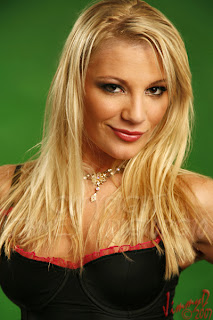 People say photographs don't lie. Mine do. -David LaChapelle
People say photographs don't lie. Mine do. -David LaChapelleDigital manipulation in pretty girl photography--well, in photography in general--is probably at an all-time high. After all, it's become rather easy for just about anyone and everyone to learn how to manipulate an image with photo processing tools.
The trick, of course, is to digitally process and enhance an image in ways that appear as if little or no manipulation has taken place. I like to call this, invisible distortion. The degree in which invisible distortion is successfully applied is heavily linked to your viewers' ability to suspend disbelief when it comes to the perceived beauty and allure of your model.
Successfully applying invisible distortion begins in production. That's where an MUA and sometimes others, or the model herself, begins altering the model's appearance: Make-up is applied, hair is coiffed, and wardrobe is selected and the model is dressed. (Assuming wardrobe will be utilized.) Much of this is designed to distort reality.
Meanwhile, the photographer is pre-visualizing the shots, selecting the right place to pose the model, setting lights or preparing to use reflectors, flags, scrims, whatever: All tools designed to modify and/or control the light which, in itself, is a distortion of reality.
The model takes her mark and, with the help of the photographer's direction, assumes a variety of poses and expressions, all of which are adopted to project various emotions or attitudes; in other words, they're designed to convey something to the viewers. Usually and once again, purposeful attempts to distort reality.
So far so good. If you're the shooter in the above detailed scenario, all is well: You and the model are appropriately prepared to capture a big, fat, two-dimensional, visual lie.
But preparing for and capturing a BFTDVL isn't the end of the story. Sometime later, you'll be processing the fruit or your photographic endeavors. Often, this is where as much, or more, skill and knowledge and creative dexterity, coupled with the discriminating applications of digital effects, will make or break your images! (For the purpose of this blog update, a digital effect is any digital manipulation of the original image as recorded by the camera.)
Few parts of this whole process scream, "Amateur" louder than the careless and reckless application of post-production processes. Often-times, obvious shortcomings in production are way more forgivable than gross derelictions of duty in the use of post-processing tools and applications.
As an example, let's look at Public Enemy #1, Photoshop's Gaussian Blur:
Gaussian Blur is a cool tool which, unless OBVIOUSLY used for an OBVIOUSLY ethereal effect, is probably responsible for more "okay" and even "really good" images morphing into garbage. (Man! There was a time I was sooooo guilty of this.) I don't know about any of you but, as I stroll through life, I don't ever seem to encounter people who have synthetic-looking, plastic, lifeless and artificial skin unless, of course, they're wearing some sort of prosthetic device. (And that device's fake "skin" is visible.)
Gaussian Blur, when appropriately and discriminatingly applied, can be a wondrous way to enhance the beauty of models. But grossly over-applying this effect almost always results in amateurish, phony-looking, and, quite frequently, absurdly distorted pictures. The gross, artfully-failed, application of Gaussian Blur only qualifies as invisible distortion to the blind and to those who are seriously and, for the most part, aesthetically-challenged. When GB is crudely and blatantly applied, suspension of disbelief quickly flies out the window.
Here's the deal: Next time you sit down to process some of your worked-hard-for, pretty girl, images, exercise a bit of restraint. Ask yourself one, simple, question: "Does this look really really good or really really phony?" Whenever you can successfully and honestly answer that question correctly, you'll find your images will often spark better responses from their viewers.
The gratuitous eye-candy at the top, pimping her cute but smallish chest puppies in an attempt to distort reality, is Alexa. I shot this last fall or winter, I can't remember exactly when and I'm too lazy to take the time to figure it out.
P.S. If you're interested in learning some effective techniques for lighting and post-processing images of your subjects, techniques that are well-suited to achieving invisible distortion, I recommend adding Skin: The Complete Guide to Digitally Lighting, Photographing, and Retouching Faces and Bodies, by Lee Varis, to your photography library. I own a copy and refer to it often.

















